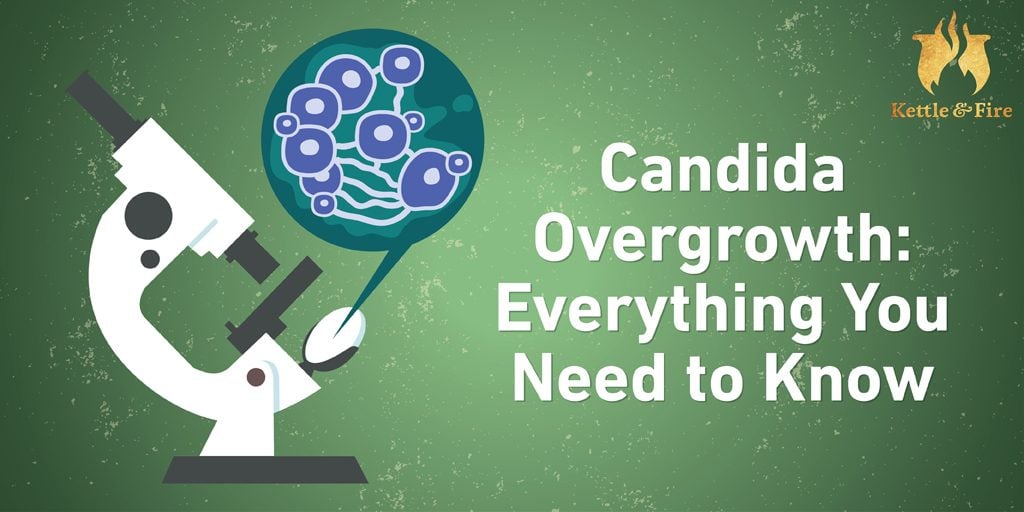Candida Overgrowth: Everything You Need to Know

Intense sugar cravings, brain fog, headaches, bloating, depression, anxiety, chronic digestive issues, and constant low energy — these are just a few of the health symptoms many of us are living with and have accepted as normal. The truth is, you’re not meant to feel this way.
These symptoms are your body’s way of communicating that something isn’t right and it needs your attention. The above symptoms are sometimes considered general health complaints that often get dismissed, but it’s important that you know it’s not just in your head. All of these symptoms are linked to a health condition called candida overgrowth.
What Is Candida Overgrowth?
Candida is a type of yeast that naturally exists in your body. It’s a normal part of your gut bacteria, and is present in mucous membranes, on the skin, and in the birth canal (1).
Under normal circumstances, candida isn’t a problem and it coexists with the other bacteria in your intestinal tract. It’s only when candida grows and overpopulates your digestive system that it can spread throughout the rest of your body and cause an infection known as candida overgrowth (2).
There are more than 20 different types of candida that can cause a fungal infection, but the most common is candida albicans, or C. albicans (2).
Candida is known as an “opportunistic” fungus because given the right conditions, there’s no limit to where it will spread. This can cause serious damage to your organs and tissues, including the brain and kidneys (2). Once candida overgrowth gets to this point, it becomes a chronic health condition called systemic candida (3).
Candida is also the fungus responsible for causing oral thrush (oral candidiasis), which is common in babies, vaginal yeast infections and urinary tract infections (4). Oral thrush results in creamy, white lesions on the surface of your tongue, cheeks, tonsils and roof of your mouth (5). Advanced cases of candidiasis can lead to septic arthritis, which is deeply invasive and causes severe pain (6).
Let’s look closer at the symptoms of candida overgrowth, the diet and lifestyle habits that cause it, how to test for candida and what you need to do to get rid of your symptoms for good.
Symptoms of Candida Overgrowth
The problem with candida is that it shares many of the same symptoms with other health problems. This is why symptoms of candida are often misdiagnosed or dismissed.
As suggested above, candida can cause discomfort throughout your entire body with symptoms such as:
- Persistent, intense sugar cravings
- Cravings for processed carbs, such as bread, pasta and pastries
- Brain fog and poor memory
- Anxiety and/or depression
- Mood swings and irritability
- Vaginal yeast infections (itching, swelling, discharge)
- Poor focus and concentration
- Developing new food sensitivities/intolerances
- A white coating on your tongue
- Athlete’s foot
- Digestive issues and stomach pain (gas, bloating, constipation, diarrhea, mucus in stool)
- Skin issues (acne, eczema, psoriasis)
- Itchy ears
- Low libido
- Unexplained exhaustion and chronic fatigue syndrome
- Skin or nail fungal infections
- Canker sores
- Flu-like symptoms
- Worsening of symptoms in humid or cold and damp environments (two conditions that encourage candida to spread and grow, which can aggravate all existing symptoms)
Although the list of symptoms is long and some are vague, you can determine if yeast is the culprit when you understand why candida overgrowth happens in the first place.
Top 5 Factors that Cause Candida Overgrowth
In most cases, candida overgrowth is triggered by factors in your diet and lifestyle. Here are the top five causes of candida overgrowth.
1. A Weakened Immune System

Nearly 70 percent of your immune system cells are found in your gut, which explains why the probiotics, or good bacteria, that help keep your gut healthy are so crucial to immunity (7). These are the same bacteria that also keep candida in check.
With most of your immune system being located in your gut, weakened immunity suggests there’s also a lack of good bacteria present, which act as a line of defense against illness and disease (8).
According to Harvard University, “if a person’s immune system is weakened by illness (especially AIDS or diabetes), malnutrition, or certain medications (corticosteroids or anticancer drugs), Candida fungi can cause symptoms more frequently” (9).
2. A High Sugar Diet

As a living organism, yeast requires “food” to survive, and it feeds off sugar. This includes cane sugar (sucrose), sugar from fruit (fructose), refined sugar and carbohydrates, and fermented sugars from alcohol. Studies show that refined sugars are the worst offenders, and mediate the growth of opportunistic bacteria, which includes yeast (10).
In other words, the more sugar you eat, the greater the likelihood that yeast can thrive and overpopulate your system.
It should be noted that while a diet high in sugar is a primary factor in candida, not every person who eats sugar will experience yeast overgrowth. Sugar is most likely to contribute to candida when you’ve been exposed to the other risk factors, such as having a compromised immune system.
That being said, refined sugar and alcohol suppress immunity and deplete healthy gut bacteria, which can contribute to creating a favorable environment for yeast overgrowth in all individuals (11)(12).
Now, you may be wondering, “Isn’t fruit good for me? If I eat it every day, am I at risk for candida?”
The scientific research and studies on candida overgrowth are currently lacking, which makes this answer unclear.
Some sources suggest that because yeast feeds off sugar, consuming excessive amounts of fruit does contribute to candida.
Other sources argue that the whole sugars (opposed to refined sugars and the fermented sugar in alcohol), trace minerals and enzymes in fruit feed our cells with the nutrients they need to produce energy long before they have the chance to feed candida, which means fruit is a no-risk situation.
However, if you’ve been exposed to other factors that increase your risk of yeast overgrowth, consuming a high carb diet may aggravate or worsen your symptoms. Refined sugar and alcohol are the primary culprits to watch out for because of their ability to alter your healthy balance of gut bacteria (13).
3. Frequent Antibiotic Use

There’s a time and place for using antibiotics. However, the problem with taking them is that they don’t discriminate between the type of bacteria they kill (14). This means they also wipe out all of your good gut bacteria, which are the bacteria that help keep candida in check and prevent overgrowth.
4. Oral Contraceptives

There’s evidence that suggests oral contraceptives are linked to recurrent yeast infections, with some studies showing the risk of vaginal yeast infections doubles when taking the birth control pill, especially in women under 24 (15)(16)(17). This may be due to the fact that exogenous estrogen from oral contraceptives can stimulate the growth of fungal cells (18).
5. Chronic Stress

Stress is a commonly overlooked cause of candida overgrowth.
Chronic stress causes systemic inflammation, which wears down your immune system (19). A weakened immune system is an open invite for the candida in your GI tract to throw a party and invite all of its friends.
Now, when you’re under intense periods of stress, your body responds by releasing stress hormones, such as cortisol, to help you cope with the situation at hand. Cortisol is very helpful in the short-term because it’s designed to help us survive life-threatening situations.
Cortisol helps your body conserve energy and increases blood flow and blood sugar levels so that you have enough stamina to flee from a dangerous situation (20).
The only problem with cortisol is that it’s a pro-inflammatory hormone, which can’t distinguish between life-threatening situations and everyday stressors, like dealing with your angry boss. So, regardless of the type of stress you’re facing, your body will always release cortisol to help you handle the stress.
Unfortunately, elevated cortisol levels also mean increased inflammation, which weakens your immunity and creates a more hospitable environment for yeast to thrive (21).
These are the most common causes of candida, but they aren’t the only ones. Some research even suggests that because yeast favors fermented sugars, not chewing your food properly — which allows it to be fermented by bacteria in your GI tract — can also encourage yeast overgrowth (22).
Can You Test for Candida?
While there are a broad assortment of suggested candida testing methods, blood and saliva tests are inconclusive because they only look for specific antibiotics, which may not be present even if there’s an overgrowth of yeast in your GI tract (23).
There’s also the spittle test, an at-home candida testing method that requires you to spit into a glass of water first thing in the morning to see if your mucous sinks, floats, or “grows legs” (which would suggest you have candida overgrowth) (24).
However, many factors can cause a candida positive result from the spittle test, including other bacteria and viruses, allergies, inflammation, eating mucus-forming foods such as dairy, and being dehydrated — which most of us are when we wake up in the morning.
Here are the candida overgrowth testing methods we suggest trying instead.
The PCR Stool Test
The most accurate way to test for candida is the PCR stool test, which can detect microbes such as yeast that regular stool tests can’t (25). This test can be ordered through your physician or a qualified natural health care practitioner.
Biohealth #401H
Lastly, there’s a test called the Biohealth #401H which is a comprehensive stool test that screens for many factors that could be responsible for your symptoms, including parasites, ova, bacteria, H. pylori and candida.
This test can be ordered by a Functional Diagnostic Nutrition Practitioner or any doctor who works with BioHealth Labs. To find a doctor who works with them, you’ll most likely need to find a practitioner working in the realm of integrative or naturopathic medicine. You can also call the lab directly and ask for help in finding someone in your area who can order this test for you.
How to Clear Up Candida
If you tested positive for candida overgrowth, or your symptoms have you convinced that yeast is the cause of your ailment, the good news is that you can cure it by reversing the factors in your diet and lifestyle that may have caused it.
It may not be realistic for you to completely ditch antibiotics and oral contraceptives. This is when supporting your gut through diet and supplementation is especially important.
A candida regimen can be strict. You have to be willing to change your eating habits in order to starve the candida and recolonize your gut with healthy bacteria.
Avoid most forms of sugar to kill candida, since sugar is the food that feeds candida. There are also a few other foods to avoid that you may not suspect.
Dietary Changes
Foods to Avoid
- Sugar (all forms, with the exception of stevia and xylitol)
- Alcohol
- Refined carbohydrates (anything made from white flour, including pizza crust, bread, pasta, pastries)
- Grains
- Starchy vegetables (sweet potatoes, carrots, potatoes, yams, parsnips, beets)
- Yeast (all forms)
- Peanuts (high in mold, which can irritate your gut)
- All processed and boxed foods
- Deli meats
- Condiments with added sugar
So, what’s left to eat?
The Best Foods to Eat to Kill Candida Overgrowth
An ideal anti-candida diet will be high in protein and healthy fats and low in carbs. You’ll want to focus on eating foods like avocado, olive oil, wild fish, organic grass-fed meat, non-starchy veggies, such as leafy greens, broccoli and asparagus, and bone broth (which also has powerful gut-healing benefits thanks to its high collagen content).
Small amounts of gluten-free grains (no more than one serving per day) such as quinoa and wild rice are also permitted.
If you love green smoothies (like we do), opt for veggie-based green smoothies with avocado, unsweetened nut milk, mint, ginger, leafy greens, citrus and cucumber. You can even add bone broth to your smoothies! Here’s how.
Certain foods have antifungal properties and can help kill off candida, which are recommended to increase in your diet:
- Garlic
- Coconut oil
- Oregano (including oil of oregano, which can be taken in a concentrated form as a supplement)
- Unpasteurized apple cider vinegar
- Cloves
- Ginger root
- Onion
Stress Management
Let’s not forget that chronic stress is also a primary cause of candida. In addition to adjusting your diet and supplement regimen, incorporate stress coping mechanisms to lower your cortisol levels and reduce inflammation. This will create a healthier internal environment, and a stronger defense against yeast overgrowth.
A few effective ways to reduce your stress levels include making time for activities you love, falling asleep before 10 p.m. to promote deeper and more restful sleep, creating a healthy work-life balance by turning your phone off at a certain hour each day, taking breaks from social media (try going offline for at least one day a week), exercising, going for walks in nature, yoga, meditation and spending time with friends who make you laugh.
How Long Do You Have to Follow a Candida Diet For?
A good starting point for following a candida cleansing regimen is at least five days, however, each person’s severity of symptoms will vary, which ultimately determines the strength of the regimen you will need to follow. For best results, you may want to work with a natural healthcare practitioner who has experience with eliminating candida.
Which Supplements Are Helpful For Killing Candida Overgrowth?
Probiotics
To begin replenishing your natural stores of healthy gut bacteria, it’s important to take a high quality probiotic supplement. You can also get probiotics from fermented foods, such as sauerkraut and coconut milk kefir or yogurt (as long as no sweetener has been added). If you take antibiotics, the best time to support your system with a probiotic supplement is after your course of antibiotics is done.
In the meantime, you can eat fermented foods to promote the growth of healthy gut bacteria. Other supplements that are said to be powerful natural antifungals and are effective for killing candida are:
- Black walnut
- Caprylic acid (found in coconut oil)
- Grapefruit seed extract
- Bentonite clay (when ingested, it may help eliminate toxins, yeast and bacteria from the intestinal tract through the stool)
All of these supplements can be found at your local health food store in the supplements aisle.
If you have symptoms of candida, it’s important to address them as early as possible. If left untreated, not only can candida spread to your other organs and tissues, but it can also lead to a chronic digestive condition called leaky gut syndrome.
Research shows that leaky gut is an underlying cause of autoimmune diseases, and several other chronic inflammatory health conditions (26). By adjusting your diet and lifestyle to support your gut health, you’ll clear up your health symptoms and prevent future health conditions down the road.
If you’re interested in learning more about treating and preventing candida overgrowth, check out:
- What is Collagen Good For?
- Slow Cooker Beef Bone Broth
- Our home page, where you can find all of our gut-healing bone broth options.





